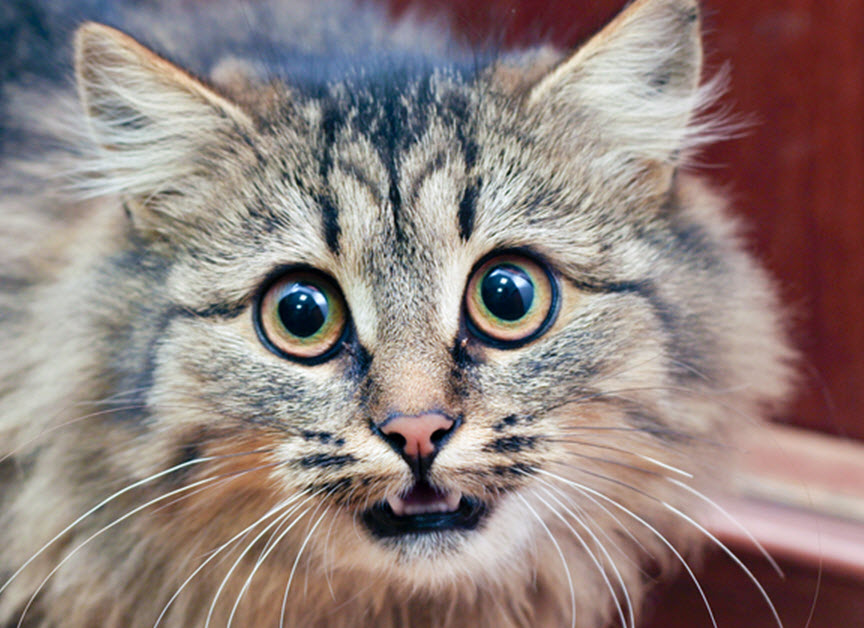Some cats are frightened of almost everything new, including other cats, people, sounds or environments. They tend to hide away from new visitors, animals or anything that is unfamiliar to them, and their lives are happier when they live with few people or other animals.
Fear by itself is a natural and necessary response we all have, but an excessive fearfulness of a cat’s surroundings is a phobia. A phobia is an irrational and unnecessary level of fear, beyond just being protective.
Why a Cat Becomes Fearful
When you experience a scared cat, you may wonder why s/he became so fearful? The answer can be a combination of factors of both nature and nurture. Some are fearful because of their genetic makeup. A parent or grandparent may have been excessively fearful, and those genes were passed on. But the genetic component may only be a piece of the puzzle.
The environmental components play an important role. A cat that’s genetically prone to fearfulness may end up being relatively secure, if properly socialized. Conversely, a genetically sound cat can grow up to be fearful if s/he had bad experiences with other animals or people during a sensitive phase of development.
The sensitive period for cats is between 2 and 7 weeks old when they see the world as it is and accept it, for good or for bad. Toward the end of that period, kittens develop a natural apprehension about things that are unfamiliar. This response of fear is a necessity to keep them from being prey to all life’s dangers. They key is to get the kitten positively associated with people and other animals before the socialization window closes.
How Cats Show Their Fear
A cat that’s frightened has several ways to respond to a fear-inducing situation. They may run away, hide, become immobile, press themselves against a wall or become aggressive. Unlike dogs, cats do not have the ability to show submissiveness to neutralize a threatening circumstance.
Their adrenal glands emit hormones called catecholamines into their bloodstream during fearfulness causing their pupils to dilate, their heart rates and blood pressure to increase and their hair to stand on end. The last effect creates that larger-than-live appearance and the familiar big bushy tail. Parts of their brain memorize visual cues, such as an angry face, while another is more closely linked to fearful noises.
Dealing with a Fearful Cat
As with most things, prevention is better than having to cure a problem. If your cat has a litter or you become the parent of a young kitten, be sure to spend time every day frequently handling and exposing the kitten(s) to new people and other pets during the first seven weeks of life.
If you are working with a fearful cat, try counterconditioning the cat by having strangers feed delicious food when s/he is hungry. The more strangers feed the cat, the less frightened of them s/he will be.
Cats that are too frightened to even accept a tossed treat from a stranger will require desensitization. One such a program would look like this:
- Shielding the cat from uncontrolled exposure to fear-inducing triggers
- Introducing strangers from a distance so they are less threatened (which may require using a harness or cat carrier to ensure the cat stays within eyesight)
- Encouraging the cat to eat or play in the person’s vicinity
- Gradually reducing the distance between the stranger and the cat
Once a cat is conditioned to excessive fearfulness, it cannot be completely reversed. But it can be substantially lessened with the use of appropriate therapy. The cat may require anti-anxiety medication from the vet. Another more natural approach would be to introduce a calming treat. These soft chew treats can be given on a regular basis or before a trigger is present, i.e. new visitors, fireworks, thunderstorms, car travel.
This blog is brought to you by Under the Weather®, makers of a line of vet-formulated functional soft chew treats for cats. Our whitefish-flavored Calming treats are designed to promote relaxation and balanced behavior during times of stress. Manufactured at our facility in Vermont.
Under the Weather is also an avid participant in the pet overpopulation cause. A portion of every sale is channeled to the Ruffy Rescue Transport Fund which finances the transportation of pets from overpopulated shelters around the U.S.A. to Vermont for adoption. The fund also covers the cost of spaying and neutering these animals. To date, we have helped save the lives of over 2,000 pets. Get to know more about Ruffy and the inspiration for our company.
View Our Products
Visit Our Blog Library




